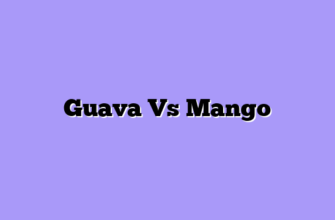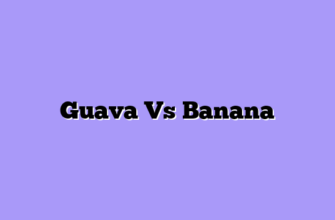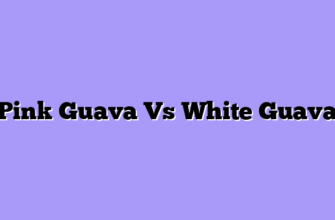Guava, a tropical fruit known for its sweet and tangy flavor, is a delightful treat enjoyed worldwide. However, the enjoyment of this fruit hinges on its ripeness. A ripe guava boasts a perfect balance of sweetness and aroma, while an unripe one can be unpleasantly tart and firm. Determining the ripeness of a guava can be tricky, but color plays a crucial role in this assessment.
Color
The color of a guava is a primary indicator of its ripeness. While the exact shade may vary depending on the variety, a general rule of thumb applies. Unripe guavas are typically green, reflecting their immaturity. As they ripen, they undergo a transformation, transitioning from green to a vibrant yellow or even a reddish hue. This color change signifies the fruit’s progression towards sweetness and softness.
For instance, the common white guava, known for its white flesh, will transition from a bright green to a pale yellow as it ripens. The pink guava, with its pink flesh, will shift from green to a vibrant pink or even a deep red. Similarly, the red guava, characterized by its red flesh, will move from green to a deep red, almost resembling a burgundy shade.

One such factor is the texture of the guava. A ripe guava will feel slightly soft to the touch, yielding to gentle pressure. This softness indicates the breakdown of starch into sugars, contributing to the fruit’s sweetness. Conversely, an unripe guava will be firm and hard, lacking the desired softness.
Another crucial factor is the aroma. A ripe guava will emit a sweet, fragrant aroma, often described as floral or fruity. This fragrance is a result of the release of volatile compounds as the fruit matures. In contrast, an unripe guava will have a faint or even absent aroma.
While color is a valuable indicator of guava ripeness, it’s essential to consider other factors like texture and aroma for a more accurate assessment. By combining these indicators, you can confidently select ripe guavas, ensuring a delightful and flavorful experience. Remember, a ripe guava is a testament to nature’s sweetness, offering a burst of tropical flavor that is both refreshing and satisfying.
Texture
- The texture of a ripe guava is a key factor in gauging its readiness for consumption. Unlike many fruits that soften as they ripen, guavas maintain a firm texture even when fully ripe. However, this firmness is not the same as the hard, unyielding texture of an unripe guava. A ripe guava, while firm, will yield slightly to gentle pressure. This subtle give is a telltale sign of its ripeness.
- To test the ripeness of a guava, gently press the fruit with your thumb. If it feels hard and unyielding, it is likely unripe. On the other hand, if it gives slightly under pressure, it is likely ripe. The pressure should not be excessive, as it could damage the fruit. A ripe guava will also have a slight give when you shake it gently.
- Another aspect of texture that indicates ripeness is the skin. The skin of a ripe guava will have a smooth, slightly wrinkled appearance. This wrinkling is a result of the fruit’s natural shrinking process as it ripens. In contrast, the skin of an unripe guava will be smooth and taut.
- The texture of the flesh is also a crucial indicator of ripeness. A ripe guava will have a soft, juicy flesh that is easily mashed with a fork. The flesh will also have a slightly grainy texture, which is a characteristic of ripe guavas. An unripe guava, on the other hand, will have a firm, dense flesh that is difficult to mash.
- While the texture is a reliable indicator of ripeness, it is not the only factor to consider. The color of the guava can also provide clues. Ripe guavas can range in color from green to yellow to red, depending on the variety. However, the color alone is not a reliable indicator of ripeness.
Smell
The aroma of a ripe guava is a sensory delight, a sweet and fragrant invitation to savor its juicy flesh. While the visual cues of a ripe guava, such as its vibrant color and slight softness, are helpful indicators, the most reliable way to determine ripeness is through its scent. As the fruit matures, it undergoes a transformation, releasing a distinctive fragrance that signals its readiness for consumption. This olfactory experience is a testament to the natural processes that occur within the guava, culminating in a burst of flavor.
To discern the ripeness of a guava through its smell, one must first approach the fruit with a gentle touch. The aroma will be most pronounced when the guava is held close to the nose, allowing the volatile compounds responsible for its fragrance to reach the olfactory receptors. A ripe guava will emit a sweet, fruity scent, reminiscent of a blend of pear, strawberry, and citrus. The intensity of the aroma will vary depending on the variety of guava, but a strong, pleasant fragrance is a sure sign of ripeness.
In contrast, an unripe guava will have a faint, almost imperceptible scent. This is because the fruit’s internal processes have not yet reached their peak, and the volatile compounds responsible for its aroma are not yet fully developed. As the guava ripens, these compounds are released, creating the characteristic fragrance that signals its readiness for consumption.

Therefore, while the smell is a reliable indicator of ripeness, it is essential to consider other factors as well. The appearance of the guava, its texture, and the time of year can all provide additional clues. A ripe guava will typically have a vibrant color, ranging from green to yellow to red, depending on the variety. The skin will also be slightly soft to the touch, indicating that the fruit has reached its peak of ripeness.
Ultimately, the best way to determine the ripeness of a guava is to combine all of these factors. By observing the fruit’s appearance, texture, and scent, one can confidently select a guava that is ripe and ready to be enjoyed. The sweet, fragrant aroma of a ripe guava is a sensory experience that is both rewarding and unforgettable, a testament to the natural beauty and bounty of this tropical fruit.
Sound
- One of the most reliable indicators of ripeness is the sound the guava makes when gently squeezed. A ripe guava will yield slightly to pressure, emitting a soft, hollow sound. This sound is a result of the fruit’s flesh becoming softer and more yielding as it ripens. Conversely, an unripe guava will feel firm and produce a dull thud when squeezed, indicating that it is still developing.
- Another auditory clue to consider is the sound the guava makes when shaken. A ripe guava, with its softer flesh, will produce a gentle, rattling sound when shaken. This sound is caused by the seeds moving freely within the fruit. In contrast, an unripe guava will feel solid and produce a muted, muffled sound when shaken, as the seeds are tightly packed within the firm flesh.
- While the sound of a guava can be a helpful indicator of ripeness, it’s important to note that other factors can also influence the sound. For instance, the size and shape of the guava can affect the sound it produces. A larger guava may sound hollower than a smaller one, even if it’s not fully ripe. Similarly, a guava with an irregular shape may produce a different sound than a perfectly round one.
- Therefore, it’s essential to combine the auditory cues with visual and tactile observations. A ripe guava will typically have a vibrant, even color, ranging from green to yellow to red, depending on the variety. The skin will also be slightly wrinkled and may have a few soft spots. Additionally, a ripe guava will have a pleasant, sweet aroma.
Taste
The most reliable indicator of guava ripeness is its color. Unripe guavas are typically green, gradually transitioning to yellow, then orange, and finally, a deep red as they ripen. The intensity of the red hue is a good gauge of ripeness, with deeper shades indicating a more mature fruit. However, it’s important to note that the color alone isn’t always a foolproof indicator, as some varieties may have a naturally darker skin even when unripe.
Another crucial factor to consider is the texture. A ripe guava will yield slightly to gentle pressure, indicating its soft and juicy interior. Conversely, an unripe guava will feel firm and hard, signifying its unripened state. This tactile test is particularly useful when the color isn’t a clear indicator of ripeness.

Finally, the taste itself is the ultimate arbiter of ripeness. A ripe guava will have a sweet and tangy flavor, with a delicate balance of both. The sweetness will be pronounced, but not overpowering, while the tartness will add a refreshing complexity. An unripe guava, on the other hand, will be astringent and sour, with a noticeable lack of sweetness.
In conclusion, determining the ripeness of a guava involves a combination of visual, tactile, and olfactory cues. While color can be a helpful indicator, it’s not always reliable. The texture, aroma, and taste are more definitive indicators of ripeness. By paying attention to these factors, you can ensure that you select a guava that is perfectly ripe and ready to deliver its full flavor potential.
Q&A
## How To Know When Guava Fruit Is Ripe
**1. Color:** Ripe guavas will have a deep, vibrant color, ranging from green to yellow, red, or even pink, depending on the variety.
**2. Feel:** A ripe guava will feel slightly soft to the touch, but not mushy.
**3. Smell:** Ripe guavas have a sweet, fragrant aroma.
**4. Stem:** The stem of a ripe guava will easily detach from the fruit.
**5. Sound:** A ripe guava will make a dull thud when gently tapped.Ripe guavas are soft to the touch, have a sweet aroma, and their skin color will vary depending on the variety, but will generally be a deeper shade of green, yellow, or red.








